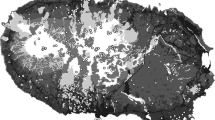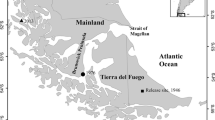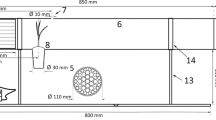Abstract
Detecting dispersal pathways is important both for understanding species range expansion and for managing nuisance species. However, direct detection is difficult. Here, we propose detecting these crucial pathways using a virtual ecology approach, simulating species dynamics using models, and virtual observations. As a case study, we developed a dispersal model based on cellular automata for the pest insect Stenotus rubrovittatus and simulated its expansion. We tested models for species expansion based on four landscape parameters as candidate pathways; these are river density, road density, area of paddy fields, and area of abandoned farmland, and validated their accuracy. We found that both road density and abandoned area models had prediction accuracy. The simulation requires simple data only to have predictive power, allowing for fast modeling and swift establishment of management plans.




Similar content being viewed by others
References
Akita Prefecture, Japan. 2016. Retrieved 20 October, 2017, from http://www.pref.akita.lg.jp/pages/archive/16019 (in Japanese).
Biodiversity Center of Japan. 2017. Retrieved 19 May, 2017, from http://www.env.go.jp/press/press.php?serial=5533
Cabral, J.S., and F.M. Schurr. 2010. Estimating demographic models for the range dynamics of plant species. Global Ecology and Biogeography 19: 85–97. https://doi.org/10.1111/j.1466-8238.2009.00492.x.
Campbell Grant, E.H., J.D. Nichols, W.H. Lowe, and W.F. Fagan. 2010. Use of multiple dispersal pathways facilitates amphibian persistence in stream networks. Proceedings of the National academy of Sciences of the United States of America 107: 6936–6940. https://doi.org/10.1073/pnas.1000266107.
Dey, S., and A. Joshi. 2006. Stability via asynchrony in drosophila Metapopulations with low migration rates. Science 312: 434–436. https://doi.org/10.1126/science.1125317.
Donaldson, J.E., C. Hui, D.M. Richardson, M.P. Robertson, B.L. Webber, and J.R.U. Wilson. 2014. Invasion trajectory of alien trees: The role of introduction pathway and planting history. Global Change Biology 20: 1527–1537. https://doi.org/10.1111/gcb.12486.
Dragićević, S. 2010. Modeling the dynamics of complex spatial systems using GIS, cellular automata and fuzzy sets applied to invasive plant species propagation. Geography Compass 4: 599–615.
Foxcroft, L., D. Richardson, and M. Rouget. 2009. Patterns of alien plant distribution at multiple spatial scales in a large national park: Implications for ecology, management and monitoring. Diversity and Distributions 15: 367–378.
GSI map. 2016. Geospatial Information Authority of Japan. Retrieved 19 May, 2017, from https://maps.gsi.go.jp.
Hayashi, Y. 2009. Wilid flower of Japan. Tokyo: Yama to Keikokusha. (in Japanese).
Hayashi, H., K. Nakazawa. 1988. Studies on the bionomics and control of the sorghum plant bug, Stenotus rubrovittatus Matsumura (Hemiptera: Miridae) 1. Habitat and seasonal prevalence in Hiroshima Prefecture. Bulletin Hiroshima Prefectural Agricultural Experiment Station 51: 45–53. (in Japanese).
Hiebert, R. 1997. Prioritizing invasive plants and planning for management. Assessment and Management of Plant Invasions.
Higuchi, H. 2010. Ecology and management of rice bugs causing pecky rice. Japanese Journal of Applied Entomology and Zoology 54: 171–188. https://doi.org/10.1303/jjaez.2010.171. (in Japanese).
Hill, M.F., A. Hastings, and L.W. Botsford. 2002. The effects of small dispersal rates on extinction times in structured metapopulation models. American Naturalist 160: 389–402. https://doi.org/10.1086/341526.
Iimura, S., Y. Saitoh, and J. Gotoh. 2004. Seasonal occurrence of sorghum plant bug, Stenotus rubrovittatus Matsumura (Hemiptera: Miridae), in Iwate Prefecture. Annual Report of The Society of Plant Protection of North Japan 55: 117–121. (in Japanese).
Integrated Biodiversity Information System (J-IBIS) available at the Biodiversity Center of Japan. Retrieved 19 May, 2017, from http://gis.biodic.go.jp/webgis/sc-023.html.
Ito, K. 2004. A possible cause of recent outbreaks of rice-ear bugs-changes in the use of paddy field Kiyomitsu. Annual Report of the Society of Plant Protection of North Japan 55: 134–139. (in Japanese).
Japan Meteorological Agency. 2017. Retrieved 25 October, 2017, from http://www.data.jma.go.jp/obd/stats/etrn/view/nml_sfc_ym.php?prec_no=32&block_no=47582&year=&month=&day=&view=p1.
Kashin, J. 2009. Optimum time for chemical control of sorghum plant bug Stenotus rubrovittatus (Hemiptera: Miridae) in Scirpus juncoides Roxb. var. ohwianus-infested rice fields. Annual Report of The Society of Plant Protection of North Japan 60: 159–162. http://doi.org/10.11455/kitanihon.2009.60_159. (in Japanese).
Kashin, J., N. Hatanaka, T. Ono, J. Oyama, and T. Kidokoro. 2009. Effect of Scirpus juncoides Roxb. var. ohwianus on occurrence of sorghum plant bug, Stenotus rubrovittatus (Matsumura) (Hemiptera: Miridae) and pecky rice. Japanese Journal of Applied Entomology and Zoology 53: 7–12. (in Japanese).
Kinlan, B.P., S.D. Gaines, B.P. Kinlan, and S.D. Gaines. 2003. Propagule dispersal in marine and terrestrial environments: A community perspective. Ecology 84: 2007–2020.
Kiritani, K. 2006. Predicting impacts of global warming on population dynamics and distribution of arthropods in Japan. Population Ecology 48: 5–12. https://doi.org/10.1007/s10144-005-0225-0.
Kobayashi, T., T. Sakurai, M. Sakakibara, and T. Watanabe. 2011. Multiple origins of outbreak populations of a native insect pest in an agro-ecosystem. Bulletin of Entomological Research 101: 313–324.
Koike, F., and K. Iwasaki. 2011. A simple range expansion model of multiple pathways: the case of nonindigenous green crab Carcinus aestuarii in Japanese waters. Biological Invasions 13: 459–470.
Kuroe, M., N. Yamaguchi, T. Kadoya, and T. Miyashita. 2011. Matrix heterogeneity affects population size of the harvest mice: Bayesian estimation of matrix resistance and model validation. Oikos 120: 271–279. https://doi.org/10.1111/j.1600-0706.2010.18697.x.
Levey, D.J. 2005. Effects of landscape corridors on seed dispersal by birds. Science 309: 146–148. https://doi.org/10.1126/science.1111479.
Logan, J.A., J. Régnière, and J.A. Powell. 2003. Assessing the impacts of global warming on forest pest dynamics. Frontiers in Ecology and the Environment 1: 130–137. https://doi.org/10.1890/1540-9295(2003)001[0130:ATIOGW]2.0.CO;2.
MinGW.org Project. 2017. Retrieved 19 May, 2017, from http://mingw.org.
Ministry of Agriculture, Forestry and Fisheries. 2017. Occurrence Prediction Project. Retrieved May 19, 2017, from http://www.maff.go.jp/j/syouan/syokubo/gaicyu/.
Ministry of Land, Infrastructure, Transport and Tourism, Japan. 2017. Retrieved 19 May, 2017, from http://nlftp.mlit.go.jp/ksj-e/index.html.
Nagasawa, A., and H. Higuchi. 2012. Suitability of poaceous plants for nymphal growth of the pecky rice bugs Trigonotylus caelestialium and Stenotus rubrovittatus (Hemiptera: Miridae) in Niigata, Japan. Applied Entomology and Zoology 47: 421–427. https://doi.org/10.1007/s13355-012-0135-5.
Nagasawa, A., A. Takahashi, and H. Higuchi. 2012. Host plant use for oviposition by Trigonotylus caelestialium (Hemiptera: Miridae) and Stenotus rubrovittatus (Hemiptera: Miridae). Applied Entomology and Zoology 47: 331–339. https://doi.org/10.1007/s13355-012-0123-9.
Nathan, R. 2001. The challenges of studying dispersal. Trends in Ecology & Evolution 16: 481–483. https://doi.org/10.1016/S0169-5347(01)02272-8.
Ohtomo, R. 2013. Occurrence and control of Stenotus rubrovittatus (Hemiptera: Miridae) in Touhoku area in Japan. Japanese Journal of Applied Entomology and Zoology 57: 137–149. https://doi.org/10.1303/jjaez.2013.137. (in Japanese).
Osawa, T., and K. Ito. 2015. A rapid method for constructing precaution maps based on a simple virtual ecology model: A case study on the range expansion of the invasive aquatic species Limnoperna fortunei. Population Ecology 57: 529–538. https://doi.org/10.1007/s10144-015-0493-2.
Osawa, T., H. Mitsuhashi, H. Niwa, and A. Ushimaru. 2011. The role of river confluences and meanderings in preserving local hot spots for threatened plant species in riparian ecosystems. Aquatic Conservation: Marine and Freshwater Ecosystems 21: 358–363. https://doi.org/10.1002/aqc.1194.
Osawa, T., T. Kadoya, and K. Kohyama. 2015. 5- and 10-km mesh datasets of agricultural land use based on governmental statistics for 1970–2005. Ecological Research 30: 757. https://doi.org/10.1007/s11284-015-1290-2.
Osawa, T., S. Okawa, S. Kurokawa, and S. Ando. 2016. Generating an agricultural risk map based on limited ecological information: A case study using Sicyos angulatus. Ambio 45: 895–903. https://doi.org/10.1007/s13280-016-0782-9.
Pagel, J., and F.M. Schurr. 2012. Forecasting species ranges by statistical estimation of ecological niches and spatial population dynamics. Global Ecology and Biogeography 21: 293–304. https://doi.org/10.1111/j.1466-8238.2011.00663.x.
Pyšek, P., V. Jarošík, and J. Pergl. 2011. Alien plants introduced by different pathways differ in invasion success: Unintentional introductions as a threat to natural areas. PLoS ONE. https://doi.org/10.1371/journal.pone.0024890.
R Development Core Team, Vienna, Austria. 2015. Retrieved 25 October, 2017, from https://cran.r-project.org/.
Rácz, É. V. P., and M. Bulla. 2003. Cellular automata models of environmental processes. In Proceedings of the international conference in memoriam John von Neumann, 109–119.
Ricketts, T.H. 2001. The matrix matters: Effective isolation in fragmented landscapes. The American Naturalist 158: 87–99. https://doi.org/10.1086/320863.
Shea, K., H. Possingham, and W. Murdoch. 2002. Active adaptive management in insect pest and weed control: Intervention with a plan for learning. Ecological 12:927–936
Shintani, Y. 2009. Effect of seasonal variation in host-plant quality on the rice leaf bug, Trigonotylus caelestialium. Entomologia Experimentalis et Applicata 133: 128–135. https://doi.org/10.1111/j.1570-7458.2009.00915.x.
Skarpaas, O., K. Shea, and J.M. Bullock. 2005. Optimizing dispersal study design by Monte Carlo simulation. Journal of Applied Ecology 42: 731–739. https://doi.org/10.1111/j.1365-2664.2005.01056.x.
Tabuchi, K., T. Ichita, R. Ohtomo, J. Kashin, T. Takagi, T. Niiyama, Y. Takahashi, J. Nagamine, et al. 2015. Rice bugs in the Tohoku Region: Their occurrence and damage from 2003 to 2013. Bulletin of the National Agricultural Research Center for Tohoku Region 117: 63–115.
Tabuchi, K., T. Murakami, S. Okudera, S. Furihata, M. Sakakibara, A. Takahashi, and T. Yasuda. 2017. Predicting potential rice damage by insect pests using land use data: A 3-year study for area-wide pest management. Agriculture, Ecosystems and Environment 249: 4–11. https://doi.org/10.1016/j.agee.2017.08.009.
Takada, M. B., A. Yoshioka, S. Takagi, S. Iwabuchi, and I. Washitani. 2012. Multiple spatial scale factors affecting mirid bug abundance and damage level in organic rice paddies. Biological Control 60: 169–174. https://doi.org/10.1016/j.biocontrol.2011.11.011.
Tohoku Agricultural Research Center, NARO. 2015. Retrieved 19 May, 2017, from http://www.naro.affrc.go.jp/publicity_report/publication/files/tohoku117-v2.xlsx.
Watanabe, T., and H. Higuchi. 2006. Recent occurrence and problem of rice bugs. Plant Protection 60: 201–203. (in Japanese).
Wilson, J.R.U., E.E. Dormontt, P.J. Prentis, A.J. Lowe, and D.M. Richardson. 2009. Something in the way you move: Dispersal pathways affect invasion success. Trends in Ecology & Evolution 24: 136–144. https://doi.org/10.1016/j.tree.2008.10.007.
Yasuda, M. 2012. Does surrounding landscape composition affect agricultural pest abundances? Plant Protection 66: 366. (in Japanese).
Yasuda, M., T. Mitsunaga, A. Takeda, K. Tabuchi, K. Oku, T. Yasuda, and T. Watanabe. 2011. Comparison of the effects of landscape composition on two mirid species in Japanese rice paddies. Applied Entomology and Zoology 46: 519–525. https://doi.org/10.1007/s13355-011-0071-9.
Yokota, H., and T. Suzuki. 2008. Most effective timing of mowing on the population density of the nymphs of the overwintering generation of Stenotus rubrovittatus in the footpath between paddy fields. Annual Report of the Society of Plant Protection of North Japan 59: 116–119. (in Japanese).
Yokota, H., M. Terata, K. Chiba, and T. Suzuki. 2009. Timing of control of sorghum plant bug Stenotus rubrovittatus by regional cooperative control. Annual Report of the Society of Plant Protection of North Japan 60: 155–158. http://doi.org/10.11455/kitanihon.2009.60_155. (in Japanese).
Yoshioka, A., M.B. Takada, and I. Washitani. 2014. Landscape effects of a non-native grass facilitate source populations of a native generalist bug, Stenotus rubrovittatus, in a heterogeneous agricultural landscape. Journal of Insect Science 14: 1–14. https://doi.org/10.1093/jis/14.1.110.
Zurell, D., U. Berger, J.S. Cabral, F. Jeltsch, C.N. Meynard, T. Münkemüller, N. Nehrbass, J. Pagel, et al. 2010. The virtual ecologist approach: Simulating data and observers. Oikos 119: 622–635. https://doi.org/10.1111/j.1600-0706.2009.18284.x.
Author information
Authors and Affiliations
Corresponding author
Electronic supplementary material
Below is the link to the electronic supplementary material.
Rights and permissions
About this article
Cite this article
Osawa, T., Yamasaki, K., Tabuchi, K. et al. Detecting crucial dispersal pathways using a virtual ecology approach: A case study of the mirid bug Stenotus rubrovittatus. Ambio 47, 806–815 (2018). https://doi.org/10.1007/s13280-018-1026-y
Received:
Revised:
Accepted:
Published:
Issue Date:
DOI: https://doi.org/10.1007/s13280-018-1026-y




